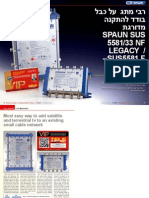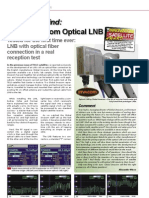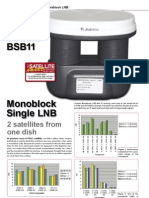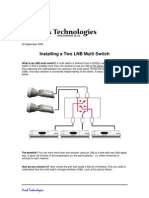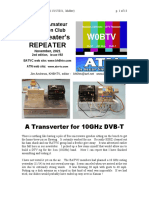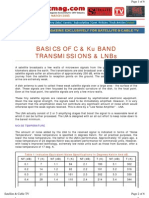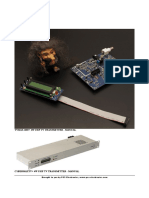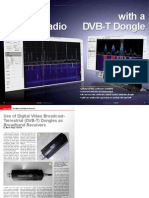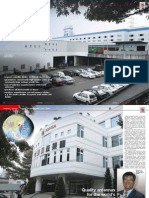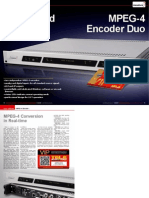Maxing Electronic Technology MX Lnbs Of: Test Report Ku Band Lnbs
Maxing Electronic Technology MX Lnbs Of: Test Report Ku Band Lnbs
Uploaded by
Alexander WieseCopyright:
Available Formats
Maxing Electronic Technology MX Lnbs Of: Test Report Ku Band Lnbs
Maxing Electronic Technology MX Lnbs Of: Test Report Ku Band Lnbs
Uploaded by
Alexander WieseOriginal Description:
Original Title
Copyright
Available Formats
Share this document
Did you find this document useful?
Is this content inappropriate?
Copyright:
Available Formats
Maxing Electronic Technology MX Lnbs Of: Test Report Ku Band Lnbs
Maxing Electronic Technology MX Lnbs Of: Test Report Ku Band Lnbs
Uploaded by
Alexander WieseCopyright:
Available Formats
54 55 TELE-audiovision International The Worlds Leading Digital TV Industry Publication 09-10/2014 www.TELE-audiovision.com www.TELE-audiovision.
com 09-10/2014 TELE-audiovision International
Single and Quad LNBs excellent for receiving
weak satellites
Twin LNB ideal solution for strong satellites
and extensive distribution systems
excellent workmanship
performance equal to other best quality
LNBs on the market
Maxing
Electronic
Technology
MX LNBs of
TEST REPORT Ku band LNBs
09-10/2014
www.TELE-audiovision.com/14/09/maxing
56 TELE-audiovision International The Worlds Leading Digital TV Industry Publication 09-10/2014 www.TELE-audiovision.com
TEST REPORT Ku band LNBs
MAXING MX-16, MX-KT22C, MX-KQ24C
Excellent workmanship give excellent
reception results
Good For Strong
and Weak Satellites
We have already pre-
sented one LNB of Maxing
Electronic Technology the
MB04 universal LNB for Ku
Band with an integrated DiS-
EqC switch (see TELE-au-
diovision 07-08/2014). This
time we picked some other
LNBs of their huge collection
of models, namely the more
commonly used versions of
Single, Twin and Quad LNBs
for Ku Band. Maxing gave
them these model names:
MX-16, MX-KT22C and MX-
KQ24C respectively.
The LNBs we put to our
test bench this time looked
from the outset typical for
Ku Band LNBs. They were
fnished off very well. The
only small drawback we no-
ticed was that their labels
were made of paper. So,
you can not expect them to
survive long when installed
outside on a dish. How-
ever, do you really care?
Once installed, you usually
do not pay any more atten-
tion to the LNB on your dish.
Even if the label is eventu-
ally peeled off by rain and
wind this will not trigger any
problem or esthetic discom-
fort. Thats why we do not
should know that it was a
low noise (NF=0.2 dB) con-
temporary LNB of very good
quality. We decided to use
the LNB poiting to the AS-
TRA satellite on 19.2 East.
Although this satellite was
very strong in our location,
it did not necessarily mean
that the test was easier to
pass.
In such environment
(Toroidal dish and strong sig-
nals) you may expect quite
some interference from
neighboring satellites so ad-
ditional to the low noise fg-
ure the LNB under test must
also offer a low phase noise,
high cross polarization isola-
regard this as a serious im-
perfection.
What really counts is the
performance. We decided
to use our Toroidal multi-
feed dish with 8 LNBs. For
the purpose of this test we
replaced one of its LNBs
with one by one the Max-
ing LNBs. The original LNB
served as the reference to
which the Maxing MX LNBs
were to be compared to. You
tion and high resistance to
intermodulation. The most
practical way to evaluate all
those parameters at once
is to compare the LNB un-
der test to another one of a
different brand. And thats
what we did.
As usually, we compared
the LNB power output which
is directly related to signal
strength and Modulation
Error Ratio (MER) which in
turn is related to the signal
quality. The frst two graphs
present the signal strength.
Evidently, the MX-16 was
weaker than our reference,
the MX-KT22C was visibly
stronger and the MX-KQ24C
was more or less equal.
OPINION
EXPERT
+
RECOMMENDED
PRODUCT BY
Jacek Pawlowski
Test Center
Poland
MAXING MX-16,
MX-KT22C, MX-KQ24C
Ku band LNBs
58 59 TELE-audiovision International The Worlds Leading Digital TV Industry Publication 09-10/2014 www.TELE-audiovision.com www.TELE-audiovision.com 09-10/2014 TELE-audiovision International
What is worth mentioning,
both outputs of the Twin LNB
and all four outputs of the
Quad LNB were almost iden-
tical. So none of the outputs
was weaker or stronger than
the others with the same
LNB.
Then we measured and
processed the MER results.
And here we had another
picture. We may say that
the MX-16 matched our ref-
erence, the MX-KT22C was
somewhat worse and the
MX-KQ24C was again almost
equal to the reference.
The reason for this is
clear: the MX-KT22C has
been designed as a high
output LNB and due to that
its noise performance is not
as good as the normal out-
put level companions (Single
and Quad in this case), whch
is due to increased inter-
modulation in such high gain
LNB. However, this makes
this LNB a favorite for re-
ceiving strong satellites
connected to a distribution
system with signifcant sig-
nal loss due to long cables
or many switches.
The MX-16 and MX-KQ24C
did not have such a strong
output signal but performed
very well in signal qual-
ity measurements. We can
recommend them even for
diffcult reception condi-
tions. They they perform as
well as the best LNBs on the
market.
Finally, we measured cur-
rent consumption of all
LNBs. Here are the results:
MX-1672 mA
MX-KT22C104 mA
MX-KQ24C152 mA.
The d.c. currents are quite
reasonable and similar to
other devices of this kind.
They will not cause any
problem for any receiver or
multiswitch.
Excellent noise performance of the Single and Quad LNBs:
MX-11 and MX-KQ24C
Very strong output of the Twin LNB: MX-KT22H
lables made of paper
TELE-audiovision already tested the
MB04, a LNB with integrated DiSEqC
switch
http://www.tele-audiovision.com/
TELE-audiovision-1407/eng/maxing.pdf
You might also like
- If by Rudyard Kipling Lesson PlanDocument6 pagesIf by Rudyard Kipling Lesson PlanSon Yong100% (10)
- Galaxy Dx959 ModsDocument6 pagesGalaxy Dx959 ModsAdam100% (1)
- LEA 1601 Curing Monolithics Containing Hydraulic CementDocument4 pagesLEA 1601 Curing Monolithics Containing Hydraulic CementMichelle Wilson100% (1)
- Homebrew RF Transceiver DesignDocument41 pagesHomebrew RF Transceiver DesignDefaultAnomoly100% (10)
- Practice: 1. Reading ComprehensionDocument2 pagesPractice: 1. Reading ComprehensionÁgota Kármán100% (2)
- 47Document2 pages47gplese0No ratings yet
- SpaunDocument5 pagesSpauntelesatellitehebrewNo ratings yet
- Cascadable SCR Multiswitches Spaun Sus 5581/33 NF Legacy & Sus 5581 FDocument5 pagesCascadable SCR Multiswitches Spaun Sus 5581/33 NF Legacy & Sus 5581 FAlexander WieseNo ratings yet
- Cascadable SCR Multiswitches Spaun SUS 5581/33 NF Legacy & SUS 5581 FDocument5 pagesCascadable SCR Multiswitches Spaun SUS 5581/33 NF Legacy & SUS 5581 FAlexander WieseNo ratings yet
- SpaunDocument5 pagesSpaunAlexander WieseNo ratings yet
- Cascadeerbare SCR Multiswitches Spaun Sus 5581/33 NF Legacy & Sus 5581 FDocument5 pagesCascadeerbare SCR Multiswitches Spaun Sus 5581/33 NF Legacy & Sus 5581 FAlexander WieseNo ratings yet
- Spaun Sus 21 F Single Cable Router: TEST REPORT One Cable Solution For Satellite and TerrestrialDocument4 pagesSpaun Sus 21 F Single Cable Router: TEST REPORT One Cable Solution For Satellite and TerrestrialAlexander WieseNo ratings yet
- Maxing Mb04 Universal LNB With Built-In Diseqc SwitchDocument3 pagesMaxing Mb04 Universal LNB With Built-In Diseqc SwitchAlexander WieseNo ratings yet
- SpaunDocument5 pagesSpaunAlexander WieseNo ratings yet
- TELE-audiovision International - The World‘s Largest Digital TV Trade Magazine TELE-audiovision International - 全球发行量最大的数字电视杂志Document5 pagesTELE-audiovision International - The World‘s Largest Digital TV Trade Magazine TELE-audiovision International - 全球发行量最大的数字电视杂志Alexander WieseNo ratings yet
- Global Invacom Optical LNB: First of Its KindDocument4 pagesGlobal Invacom Optical LNB: First of Its KindAlexander WieseNo ratings yet
- Global Invacom: Installation Accessories For Optical LNBS: Business VoucherDocument5 pagesGlobal Invacom: Installation Accessories For Optical LNBS: Business VoucherAlexander WieseNo ratings yet
- Low Noise Block Down ConverterDocument4 pagesLow Noise Block Down Converteryogesh_kumar1983No ratings yet
- 0601 MtiDocument2 pages0601 MtiAlexander WieseNo ratings yet
- Low-Noise Block Downconverter: Satellite Dishes Satellite TVDocument12 pagesLow-Noise Block Downconverter: Satellite Dishes Satellite TVGetachew MekonnenNo ratings yet
- Global Invacom Optical LNB: The Satellite Reception RevolutionDocument7 pagesGlobal Invacom Optical LNB: The Satellite Reception RevolutionAlexander WieseNo ratings yet
- 0809 GtsatDocument3 pages0809 GtsatAlexander WieseNo ratings yet
- Chaparral A Leading Universal Single LNBF Manufacturer Amp SupplierDocument2 pagesChaparral A Leading Universal Single LNBF Manufacturer Amp SupplierRodolfo Jacinto HernàndezNo ratings yet
- 12 TH ReportDocument7 pages12 TH ReportDonna NobartNo ratings yet
- TV Rptrs RPTR 127Document9 pagesTV Rptrs RPTR 127Benjamin DoverNo ratings yet
- Wellbrook Phased ArrayDocument15 pagesWellbrook Phased ArraysfrahmNo ratings yet
- 0707 JiuzhouDocument2 pages0707 JiuzhouAlexander WieseNo ratings yet
- Understanding LNB Specifications: The LNB Should Accomplish This Without Adding Too Many Spurious Signals of Its OwnDocument9 pagesUnderstanding LNB Specifications: The LNB Should Accomplish This Without Adding Too Many Spurious Signals of Its Owngianhu100% (1)
- TV Rptrs RPTR 118Document10 pagesTV Rptrs RPTR 118Benjamin DoverNo ratings yet
- Installing A Two LNB Multi SwitchDocument4 pagesInstalling A Two LNB Multi SwitchsabrijamousNo ratings yet
- 0703 SpaunDocument2 pages0703 SpaunAlexander WieseNo ratings yet
- Transcription SC2Document21 pagesTranscription SC2hello worldNo ratings yet
- Optical Splitters Of: Global InvacomDocument3 pagesOptical Splitters Of: Global InvacomAlexander WieseNo ratings yet
- Hands On 3D2LNBDocument7 pagesHands On 3D2LNBbernhard-fingerNo ratings yet
- Multiswitch SCR Dari SPAUN Yang Bisa DigandengDocument5 pagesMultiswitch SCR Dari SPAUN Yang Bisa DigandengAlexander WieseNo ratings yet
- FT 901modsDocument3 pagesFT 901modsMark WolstenholmeNo ratings yet
- C-Band Dro LNB Teardown - Kf5obs - IpDocument8 pagesC-Band Dro LNB Teardown - Kf5obs - Ipkhanafzaal2576No ratings yet
- NBSC - The Prototype Televisor MK - 4Document2 pagesNBSC - The Prototype Televisor MK - 4Sebastian CostaNo ratings yet
- 10 Things To Look For in An LNBDocument8 pages10 Things To Look For in An LNBivanlawms6745No ratings yet
- Kaskádovatelný SCR Multiswitch Od SpaunDocument5 pagesKaskádovatelný SCR Multiswitch Od SpaunAlexander WieseNo ratings yet
- TV Repeater'S Repeater: A Transverter For 10Ghz DVB-TDocument13 pagesTV Repeater'S Repeater: A Transverter For 10Ghz DVB-TBenjamin DoverNo ratings yet
- Basics of C & Ku Band Transmissions & LNBS: Noise TemperatureDocument6 pagesBasics of C & Ku Band Transmissions & LNBS: Noise TemperatureAhsan RazaNo ratings yet
- Unicable Datasheet 174Document6 pagesUnicable Datasheet 174Mohamed HegazyNo ratings yet
- Radioastronomy Hydrogen Line Frontend On A BudgetDocument15 pagesRadioastronomy Hydrogen Line Frontend On A BudgetrbsantiNo ratings yet
- QS03 99 CampbellDocument5 pagesQS03 99 CampbellekibentoNo ratings yet
- Untitled 1Document3 pagesUntitled 1baboosabNo ratings yet
- Wideband Microwave Amplifier DesignDocument11 pagesWideband Microwave Amplifier DesignbaymanNo ratings yet
- LNB PDFDocument3 pagesLNB PDFsuhel000No ratings yet
- N2qv-Wu2x-N5dx CQ Magazine May 2018Document6 pagesN2qv-Wu2x-N5dx CQ Magazine May 2018Tariq Mundiya0% (1)
- Where Do You Start?: 27Mhz Door Knob AlarmDocument72 pagesWhere Do You Start?: 27Mhz Door Knob AlarmsergioNo ratings yet
- Understanding Digital TV MERDocument73 pagesUnderstanding Digital TV MERTin LeNo ratings yet
- A Miniature HF To VHF AM-FM Receiver Using The NE605Document2 pagesA Miniature HF To VHF AM-FM Receiver Using The NE605Miguel Oyarzabal100% (1)
- 0605 Max CommunicationDocument2 pages0605 Max CommunicationAlexander WieseNo ratings yet
- A Precursor To DVB-S3: Improved Satellite ModulationDocument3 pagesA Precursor To DVB-S3: Improved Satellite Modulationmbush60No ratings yet
- FM Combiner Tuning and TestingDocument24 pagesFM Combiner Tuning and TestingAli AkinNo ratings yet
- A High-Performance Homebrew TransceiverDocument35 pagesA High-Performance Homebrew Transceiververd leonardNo ratings yet
- 'UHF' Connector Test Results PDFDocument11 pages'UHF' Connector Test Results PDFtrsghstrhsNo ratings yet
- Tvmax 3000+ 4W Uhf TV Transmitter - ManualDocument17 pagesTvmax 3000+ 4W Uhf TV Transmitter - ManualRamadhan ZuhdiNo ratings yet
- Build A Homebrew Radio TelescopeDocument5 pagesBuild A Homebrew Radio Telescopemaxxand100% (2)
- EE133 - Lab 2 Using Oscillators To Generate FM SignalsDocument6 pagesEE133 - Lab 2 Using Oscillators To Generate FM Signalsapi-3725139No ratings yet
- Microelectronics Journal: Hossein Eslahi, Ali Jalali, Saman Nateghi, Jalil MazloumDocument7 pagesMicroelectronics Journal: Hossein Eslahi, Ali Jalali, Saman Nateghi, Jalil MazloumQazi KamalNo ratings yet
- 0611 GtsatDocument2 pages0611 GtsatAlexander Wiese0% (1)
- Satbeams PDFDocument4 pagesSatbeams PDFAlexander WieseNo ratings yet
- Editorial PDFDocument1 pageEditorial PDFAlexander WieseNo ratings yet
- Alpsat PDFDocument5 pagesAlpsat PDFAlexander WieseNo ratings yet
- Mktech PDFDocument7 pagesMktech PDFAlexander WieseNo ratings yet
- EICO On Top of The WorldDocument5 pagesEICO On Top of The WorldAlexander WieseNo ratings yet
- Haenlein: PVR Software For Digital TV ReceiversDocument4 pagesHaenlein: PVR Software For Digital TV ReceiversAlexander WieseNo ratings yet
- Feature Dongle PDFDocument6 pagesFeature Dongle PDFAlexander WieseNo ratings yet
- Sparos PDFDocument17 pagesSparos PDFAlexander WieseNo ratings yet
- Formuler PDFDocument9 pagesFormuler PDFAlexander WieseNo ratings yet
- Chinasatcom PDFDocument6 pagesChinasatcom PDFAlexander WieseNo ratings yet
- DVR Studio PDFDocument2 pagesDVR Studio PDFAlexander WieseNo ratings yet
- Jonsa Antennas: COMPANY REPORT Satellite Dish Manufacturer Jonsa, TaiwanDocument10 pagesJonsa Antennas: COMPANY REPORT Satellite Dish Manufacturer Jonsa, TaiwanAlexander WieseNo ratings yet
- Eng TELE-audiovision 1411Document164 pagesEng TELE-audiovision 1411Alexander WieseNo ratings yet
- Cableworld PDFDocument13 pagesCableworld PDFAlexander WieseNo ratings yet
- The IMC Group Acquires Horizon: COMPANY REPORT Signal Meter Manufacturer, HORIZON, UKDocument2 pagesThe IMC Group Acquires Horizon: COMPANY REPORT Signal Meter Manufacturer, HORIZON, UKAlexander WieseNo ratings yet
- Titanium Asc1: TEST REPORT Positioner For Big Satellite DishDocument11 pagesTitanium Asc1: TEST REPORT Positioner For Big Satellite DishAlexander WieseNo ratings yet
- Editorial PDFDocument1 pageEditorial PDFAlexander WieseNo ratings yet
- By Perfectvision: Product Report Coax Cable DispenserDocument9 pagesBy Perfectvision: Product Report Coax Cable DispenserAlexander WieseNo ratings yet
- IMOResolutionMSC 288 (87) Adopted14mai2010Document6 pagesIMOResolutionMSC 288 (87) Adopted14mai2010Isabel SobralNo ratings yet
- Indwdhi 20240131Document4 pagesIndwdhi 20240131qilkyleNo ratings yet
- Physics Formula'S: Si-UnitDocument3 pagesPhysics Formula'S: Si-UnitCharu KhannaNo ratings yet
- Writing AssessmentDocument2 pagesWriting AssessmentVALERIA ISABEL BARRERA POLANCONo ratings yet
- The Social Impacts of Television and Social MediaDocument4 pagesThe Social Impacts of Television and Social MediaClaire Kaye Carson100% (1)
- Dieter Schwarz - Freemasonry - Ideology, Organization and Policy (1944) - PDF (TKRG)Document108 pagesDieter Schwarz - Freemasonry - Ideology, Organization and Policy (1944) - PDF (TKRG)CristianFachelli100% (1)
- Rmaniae (Classical Philology Xvi 1921)Document6 pagesRmaniae (Classical Philology Xvi 1921)Giacomo PediniNo ratings yet
- Chapter 4.0Document105 pagesChapter 4.0adlenaeliyaNo ratings yet
- Air Conditioner - User Manual - Télécommande (DB98-33129A, For MR-DH00, DH00U & DC00) - enDocument14 pagesAir Conditioner - User Manual - Télécommande (DB98-33129A, For MR-DH00, DH00U & DC00) - enBruno LNo ratings yet
- Exercises - Free FallDocument5 pagesExercises - Free FallEng-Al Raie SaadNo ratings yet
- Exam Ques 1Document3 pagesExam Ques 1Tope YomiNo ratings yet
- Dramatic Change With NLPDocument10 pagesDramatic Change With NLPyatinb100% (1)
- Paper Pool ReportDocument3 pagesPaper Pool Reportapi-254295669No ratings yet
- Med Term Handout For FinalsDocument10 pagesMed Term Handout For FinalsMark Duruin100% (1)
- Managing Service Quality: An International Journal: Article InformationDocument4 pagesManaging Service Quality: An International Journal: Article InformationMujaddidul AmriNo ratings yet
- Final PPT LokpalDocument11 pagesFinal PPT LokpalAditya KhanzodeNo ratings yet
- Solutions To The 84th William Lowell Putnam Mathematical Competition Saturday, December 2, 2023Document5 pagesSolutions To The 84th William Lowell Putnam Mathematical Competition Saturday, December 2, 2023Anh PhươngNo ratings yet
- ConstructionTypes Wed Sep 29 2021 16-14-15 GMT+0000 (Greenwich Mean Time)Document1 pageConstructionTypes Wed Sep 29 2021 16-14-15 GMT+0000 (Greenwich Mean Time)Arturo PleitezNo ratings yet
- Organic Chemistry 12 STD Question Bank (MLM) With AnswersDocument41 pagesOrganic Chemistry 12 STD Question Bank (MLM) With AnswersAbhiNo ratings yet
- Tischler Studio GuideDocument104 pagesTischler Studio GuideYasminNo ratings yet
- Brksec 3455 PDFDocument173 pagesBrksec 3455 PDFRahul BennyNo ratings yet
- CCASBCM105Document57 pagesCCASBCM105Monisha RajamaniNo ratings yet
- Erin - Sousa - Final CH 5 - Twocolumnnoteform RevDocument6 pagesErin - Sousa - Final CH 5 - Twocolumnnoteform Revapi-429757438No ratings yet
- NSEB 2022 Question Paper With SolutionsDocument24 pagesNSEB 2022 Question Paper With Solutionspritishahdeo71725No ratings yet
- ResumeDocument2 pagesResumealy torresNo ratings yet
- PangeaDocument33 pagesPangeamikeful mirallesNo ratings yet






